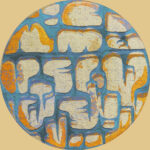Visualizing
the Virus
On the basis of participant-observation research with the Polaroid SX-70 conducted within the context of Covid quarantine on the unclaimed dead in the limbo of the freezer-truck networks of disaster morgues and their connection to Hart Island, the largest mass grave site in the United States that may also be the largest cemetery for victims of the AIDS epidemic, I produced a first film, Untitled (Melancholy as Medium). [1] A commission from the Ford Foundation Gallery, the short experimental film premiered on June 9, 2021 in the fifth online chapter, Melancholy as Medium, which I conceived for the exhibition, Indisposable: Structures of Support after the ADA, as an activist wake. [2] Unfolding a ritual of mediumship, the film catalyzes our outraged grief for the ongoing work of living with more than one virus, amidst more than one pandemic, carrying our as yet unaddressed losses into the battles we’re still waging in the name of supports for the thriving of Black, Brown, Indigenous, crip, queer, and trans vitalities. Centered on a set of fragile Polaroids, the film conjures with the material fragility of analog photography to commune with the incalculable but still powerful presence of unredressed loss. [3] In reversing the primacy of showing over telling, the film incorporates disability access as aesthetic gain by making closed captioning integral and image description its primary vehicle.
Melancholy understood and practiced as medium is no mere synonym for sad. Nor is it some fancy, multisyllabic word for grief. Rather, Untitled (Melancholy as Medium) advocates for melancholy as a praxis. For from necessarily isolating, melancholy as praxis bonds us in a critical form of denied relation. That is, melancholy practiced in and as the wild binds us together in a presumptively unnatural assembly with the dead and dying we also are. And it holds us fast in a refusal to accede to a new normal that accepts death and disposability as necessary and inevitable. Untitled (Melancholy as Medium) builds on my theoretical work on care for death and is dedicated to opening a portal onto the praxis of a kind of unhinged melancholy as medium, a queer kind of wild care for the dead, dying and consigned to death to confront the necropolitics of disposability. [4]
And yet, while Untitled (Melancholy as Medium) may be about catalyzing rage-grief resistance to normalization and moving on, it is not inimical to joy. We might, rather, call the melancholy it advocates a praxis of melancholy joy off the hook of prescribed happiness, and mourning as a ritualized stage that is also contained by the commercial consumption of a funeral industrial complex. [5] That is, a praxis of the obscene, that gets close to death and dying to contest the terms of that dying. Not mourning and militancy but mourning as militancy or, rather, activated melancholy as medium, a way of channeling our outraged grief that questions the means as well as the when and where of the political and of activism – from one sick and death bed to another and not just on but also from the inhumed but not at all emptied ground of settler coloniality.
You can find a fuller discussion of this piece in a longer published essay here. You can watch Untitled (Melancholy as Medium) on Vimeo here (password: cripmelancholy).
Jill Casid, Untitled (Melancholy as Medium), in Terracotta Friendship, 2022, Documenta 15, in virtual exhibition space designed by Kang Seung Lee and co-organized by Jatiwangi Art Factory’s “Terracotta Embassy” and the National Museum of Modern and Contemporary Art, Korea.
Notes
[1] Casid, Untitled (Melancholy as Medium), film, color video with sound, 9 min. 43 seconds, new film commission for Chapter V, Melancholy as Medium, of Indisposable: Structures of Support after the Americans with Disabilities Act, Ford Foundation Gallery, June 2021. I thank Jack Kellogg for the film’s realization and Jessica A. Cooley, Ann M. Fox and Lisa Kim for the commission. The film was also shown in artists + allies iv curated by Mitra Korasheh, Signs and Symbols Gallery, August 1-September 25, 2021. And I thank Michelle Handelman for the allyship and for drawing on my theoretical work on the Necrocene for DOOMSCROLLING, a livestream video premiere of Handelman’s THE PANDEMIC SERIES (2020-2021), http://participantinc.org/seasons/season-19/doomscrolling. I am also grateful to Chi-Ming Yang and Cyle Metzger for the invitations to screen and discuss the film at the University of Pennsylvania and Bradley University.
[2] On Chapter 5 of Indisposable, consult https://www.fordfoundation.org/about/the-ford- foundation-center-for-social-justice/ford-foundation-gallery/events/indisposable-structures-of- support-after-the-ada-chapter-5/. To watch, see https://www.youtube.com/watch?v=Dmt9gjjb4ek. The evening’s session began with a performance of Transmission V (2021) by fierce pussy that was also commissioned as a printed edition in Braille and provided to participants. Holding space to ask such questions as ‘what does a collective grief doula do?’, members of the What Would an HIV Doula Do? collective Pato Hebert and Abdul-Aliy A. Muhammad read the introduction of their co-edited zine, What Does an Uprising Doula Do?. I debuted a screening of my short film, Untitled (Melancholy as Medium) made especially for Indisposable. Intervening in the telling of HIV/AIDS as history and honoring the transformative powers of Black lesbian litany and elegy, Pamela Sneed performed selections from Funeral Diva (2020) to remind us of the forms that resistance shouldn’t have to take – like survival. Master of ceremonies for the evening Heather Johnson read from her poem “Mississippi Appendectomy” and gathered session participants for a culminating convocation.
[3] See also Sarah Cascone, “Editors’ Picks: 11 Events for Your Art Calendar This Week, From a Talk With the Director of the Uffizi to a Musical Reflection on Agnes Martin,” Artnet News (June 7, 2021), https://news.artnet.com/art-world/editors-picks-june-7-2021-1972870.
[4] For my elaboration of “care for death,” see Casid, “Handle with Care” and “Pyrographies: Photography and the Good Death,” TDR: The Drama Review 56:4 (Winter 2012): 121-35 and “Pyrographies: Photography and the Good Death,” Women and Performance: a journal of feminist theory 22.1(2012): 109-31. I return to further elaborate “care for death” in the compounded Pandemic context and to the Public Feelings Salon convened by the Barnard Center for Research on Women to which I contributed a first iteration of “Handle with Care” in “They Did What They Could Do at the Time: Thinking with an after Lauren Berlant,” Art in America (July 20, 2021), https://www.artnews.com/art-in-america/features/lauren-berlant- remembrance-jill-casid-1234599248/
[5] I develop this further in Casid, “Thanatography: Working the Folds of Photography’s Wild Performativity in Capital’s Necrocene,” special issue of Photography and Culture on “Capitalism”.



